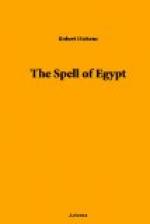and the greyness under the long arcades, all seem to
make a tremulous proclamation; all seem to whisper,
“I am very old, I am useless, I cumber the earth.”
Even the mosque of Amru, which stands also on ground
that looks gone to waste, near dingy and squat houses
built with grey bricks, seems less old than this mosque
of Ibn-Tulun. For its long facade is striped
with white and apricot, and there are lebbek-trees
growing in its court near the two columns between which
if you can pass you are assured of heaven. But
the mosque of Ibn-Tulun, seen upon a sad day, makes
a powerful impression, and from the summit of its
minaret you are summoned by the many minarets of Cairo
to make the pilgrimage of the mosques, to pass from
the “broken arches” of these Saracenic
cloisters to the “Blue Mosque,” the “Red
Mosque,” the mosques of Mohammed Ali, of Sultan
Hassan, of Kait Bey, of El-Azhar, and so on to the
Coptic church that is the silent centre of “old
Cairo.” It is said that there are over
four hundred mosques in Cairo. As I looked down
from the minaret of Ibn-Tulun, they called me through
the mist that blotted completely out all the surrounding
country, as if it would concentrate my attention upon
the places of prayer during these holy days when the
pilgrims were crowding in to depart with the Holy Carpet.
And I went down by the staircase of the house, and
in the mist I made my pilgrimage.
As every one who visits Rome goes to St. Peter’s,
so every one who visits Cairo goes to the mosque of
Mohammed Ali in the citadel, a gorgeous building in
a magnificent situation, the interior of which always
makes me think of Court functions, and of the pomp
of life, rather than of prayer and self-denial.
More attractive to me is the “Blue Mosque,”
to which I returned again and again, enticed almost
as by the fascination of the living blue of a summer
day.
This mosque, which is the mosque of Ibrahim Aga, but
which is familiarly known to its lovers as the “Blue
Mosque,” lies to the left of a ramshackle street,
and from the outside does not look specially inviting.
Even when I passed through its door, and stood in the
court beyond, at first I felt not its charm.
All looked old and rough, unkempt and in confusion.
The red and white stripes of the walls and the arches
of the arcade, the mean little place for ablution—a
pipe and a row of brass taps—led the mind
from a Neapolitan ice to a second-rate school, and
for a moment I thought of abruptly retiring and seeking
more splendid precincts. And then I looked across
the court to the arcade that lay beyond, and I saw
the exquisite “love-color” of the marvellous
tiles that gives this mosque its name.




